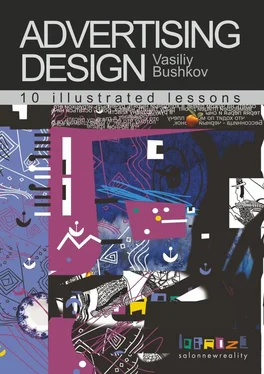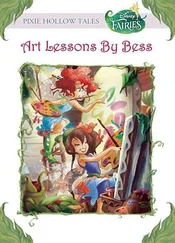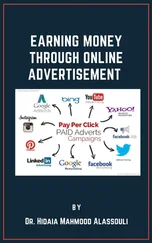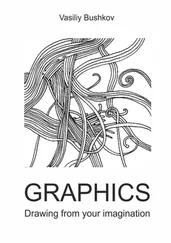Advertising design
10 illustrated lessons
Vasiliy Bushkov
Translator Matvey Bushkov
© Vasiliy Bushkov, 2018
© Matvey Bushkov, translation, 2018
ISBN 978-5-4493-8907-7
Created with Ridero smart publishing system
The “advertising design” course consists of 10 illustrated lessons and is meant to give you the specific visual language of an advertising message.
The course is based on the visual semantics – a sign and sign compositions. There’re figurative, geometric, font signs and trademarks (logos). We work with signs in different ways to create a good figurative advertising message, using such terms as plasticity, trajectory, phrase, etc. We realize that while creating a composition, the main goal is to find the way to promote goods, services and trademarks.
The course is interesting and entertaining, thanks to the set goal, using your own prepared stuff, such as photos, formal text, trademarks, and also, thanks to an opportunity to analyze similar works and rate students’ work examples.
We use CorelDRAW or Adobe Illustrator, also Photoshop if necessary.
Students’ advertising compositions are aimed at visual research and are abstractly characterized, the text contains zero information.

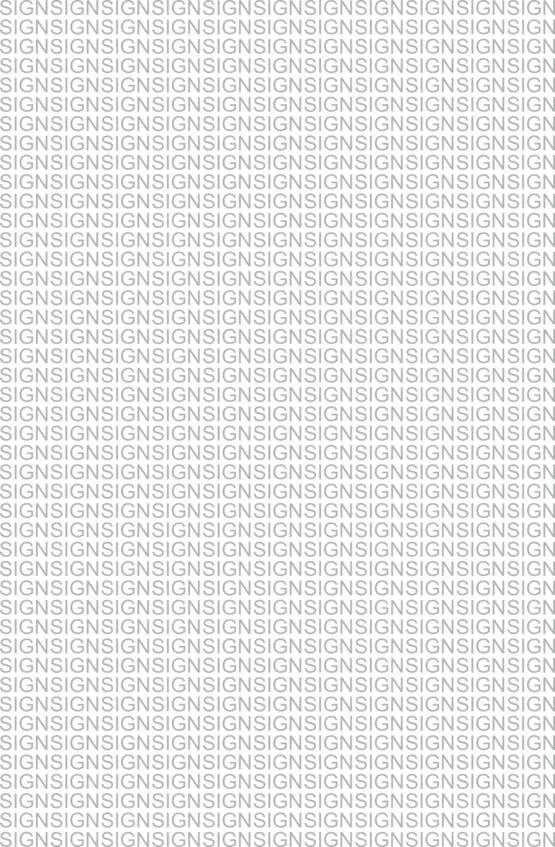
A figurative sign is used as the advertised object, a trademark is used to represent the advertiser (brand).
We carefully study the way figurative signs and trademarks are formed, we learn to create quite a simple visual text. The dominant in the advertising message is a figurative sign.
In this unit we learn to work with similar works, create sign combinations correlated in plasticity, create trajectories and phrases, use various expressive means, match the image.

First of all, we should know the definition of trademarks.
Trademark – a stylized beautiful graphic image identifying exactly an object, company or its specific activity. It’s registered and marked as R, if the trademark is still being registered – TM.
Figurative trademark – a graphic image of an object or its parts, geometric shapes or figures, it’s semantically charged.
Verbal trademark – a graphic font image used to identify only one specific company or goods, it contains no figurative elements (it includes logos and abbreviations).
Logo(abbreviation of logotype, from Greek: logos “word”, typos – “imprint”) – a verbal graphic original image, sometimes with figurative elements.
Abbreviation – a graphic image of the first letters of word phrases.
Combined trademark – a whole composition consisting of figurative and font trademarks.
Prepare figurative, geometric, font signs and trademarks for your individual work. You may download signs on the Internet. Figurative signs are placed on a white background, sometimes, on a transparent background. Try to make your content beautiful, expressive, quality, so it’d be interesting and fun to work with this “building material”. Remember about the repetition of similar colors (black, red, blue), what we often call “support”. It’s desirable that the text be topic-neutral and in a foreign language.
Конец ознакомительного фрагмента.
Текст предоставлен ООО «ЛитРес».
Прочитайте эту книгу целиком, на ЛитРес.
Безопасно оплатить книгу можно банковской картой Visa, MasterCard, Maestro, со счета мобильного телефона, с платежного терминала, в салоне МТС или Связной, через PayPal, WebMoney, Яндекс.Деньги, QIWI Кошелек, бонусными картами или другим удобным Вам способом.
